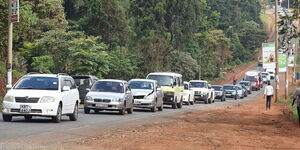After Energy and Petroleum Regulatory Authority (EPRA) hiked fuel prices on Friday, June 30, public service operators announced plans to increase fare charges in Nairobi and other parts of the country.
Speaking to Kenyans.co.ke Brendan Marshall, a traffic coordinator and member of the Matatu Owners Association (MOA) confirmed public service vehicles will increase fare charges.
Brendan insisted that the fare hikes will shield them from losses due to new fuel prices, with super petrol retailing at Ksh195 per litre, diesel at Ksh179.67 and kerosene at Ksh173.44 per litre.
"Matatus will increase fare charges in the coming days. This will protect the sector from losses because we also expect the cost of repairs and maintenance to increase," Brendan told Kenyans.co.ke.
In light of this development, there are strategies commuters can adopt to tighten their belts even as matatus hike fare charges on different routes.
Ways to Survive
Using Trains
Kenya Railways has not yet issued a notice announcing prices adjustment on committer trains plying different routes in Nairobi.
They have different services covering Syokimau, Embakasi Village, Ruiru, Kikuyu and Athi River Station. Each route has a different fare schedule.
For instance, from Nairobi Central Station to Syokimau and other dropping points costs between Ksh50- Ksh60. Boarding a train will help commuters save close to Ksh50 as matatus plying that same route charge Ksh100.
The Ruiru train covers various routes, including Pipeline, Dandora, Mtindwa, Kariobangi, Kasarani, Githurai, Kimbo, Kahawa, Kenyatta University and Ruiru. The maximum fare for those routes is Ksh60. Using a train will help residents to save Ksh40 as matatus charge between Ksh80- Ksh100.
The same applies to Kikuyu station, which passes through Highrise Estate, Thogoto, Kibera, Satelite, Lenana and Dagoretti. The maximum charge is Ksh60 which will help commuters to save Ksh20 for one trip from Nairobi.
Matatus using Ngong Road charge between Ksh60- Ksh100 during peak hours.
Off Peak Hours
Boarding matatus during off-peak hours in one way of spending less as matatu announce fare hikes.
During off-peak hours most public service operators tend to lower charges due to low demand.
For instance, travelling to Nairobi CBD from Westlands during off-peak hours, matatus charge Ksh20, whereas, during peak hours when the demand is high, they charge between Ksh40 and Ksh50.
A traffic coordinator, Brendan Marshall, confirmed that most fare charges will not be affected during off-peak hours.
"Those using matatus during off-peak hours will not be so much affected by the directive to hike fares that is because the demand is usually low," he stated.
Using Alternative Matatus
In Nairobi, there is a wide range of matatus, including brand new ones with graffiti and artwork that play loud music, as well as larger, older buses typically boarded by older Kenyans or those who prefer quiet trips.
The prices between the two also vary as the modern matatus tend to charge more than the big old buses.
So to survive, one can use the old buses to move to their various workstations. For instance, big old buses heading to Githurai and Mwiki charge Ksh50, while the new buses charge Ksh80.
Another option is connecting using several matatus, which charge affordable fares from one point to another.
Trekking can also be considered an option, especially for short distances in secure places such as moving from Upper Hill, National Library and Museum Hill to Nairobi CBD.












